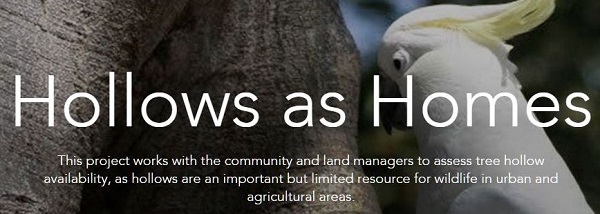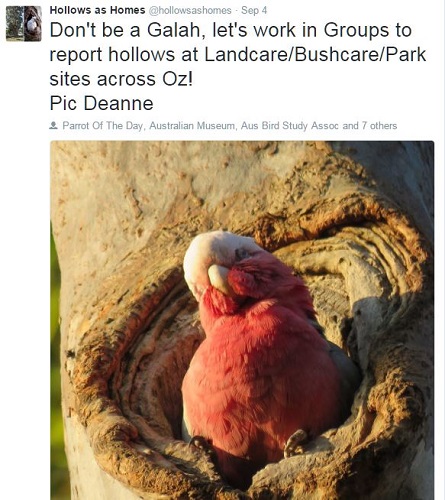Hollows as Homes
Around 300 animal species rely on tree hollows in Australia, including birds, possums, gliders, microbats, frogs, lizards, snakes, insects and spiders. Changes to the landscape from urbanisation and agriculture not only reduce the amount of trees, and homes for animals, but also create big gaps between the remaining trees and bushland. In New South Wales, terrestrial vertebrate species that are reliant on tree hollows for shelter and nests include at least 46 mammals, 81 birds, 31 reptiles and 16 frogs. Of these, 40 species are listed as threatened with extinction in New South Wales (http://www.environment.nsw.gov.au/determinations/lossofhollowtreesktp.htm), and many other species are also threatened throughout Australia (https://www.environment.gov.au/node/14582).
So important are tree hollows to our native wildlife, that their loss has been classed as a Key Threatening Process to biodiversity in New South Wales. One reason that their loss is significant is the length of time that it takes for a tree hollow to form. In Australia, there are no animals that are able to create tree hollows (e.g. wood pecker in much of the rest of the world), thus hollow creation is a slow process that relies on fungus to eat away at the tree. In some instances hollow creation is assisted by animals chewing to remove decayed wood (e.g. Cockatoos). In general, it can take decades for hollows to form, which is why large hollows, suitable for big animals such as possums, cockatoos or owls, are found in older, larger trees.
Cities and agricultural areas provide habitat for endangered animals and plants. We can encourage animals to share our cities, suburbs and farms by retaining large, hollow bearing trees; as well as remnant patches of bushland that surround these trees. Habitat valuable to wildlife comes in many forms, including a bushy backyard, a street with remnant trees, or a farm paddock dotted with big old trees. Habitat patches provide protection for animals and make it easier for them to move through the environment; even dead trees provide important habitat whether they are standing or on the ground.
In addition, it has been shown that the more trees there are in an area, the happier people are! Nest boxes and cut-in hollows are often used in areas lacking natural tree hollows, however we don’t know a lot about how animals use this substitute habitat in place of natural hollows. Many animals have specific attributes that they like in a hollow, consequently some animals may not use artificial hollows. For this reason it is important to know if nest boxes and cut-in hollows are attracting the desired animals, or, if they are being used at all. The Hollows as Homes project aims to conduct the first landscape scale assessment of tree/nest box/cut-in hollow distribution, type and wildlife use.











sm flipboard done
ReplyDelete